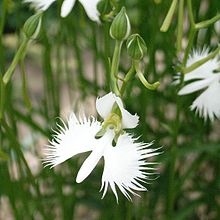http://en.wikipedia.org/wiki/Hanakotoba
| 彼岸花 / 曼珠沙華 | Higanbana / Manjushage | Red Spider Lily | Never to meet again/Lost memory/Abandonment |
| 蓮華 | Renge | Lotus | Far from the one he loves/Purity/Chastity |
| 鷺草 | Sagiso | Habenaria radiata | My thoughts will follow you into your dreams |
Anyway, much of the language has similarities to the English actually, and I wonder how many of the flowers listed here have been "borrowed" from floriography (Victorian flower language), as with other Japanese words like "Ti shaatsu" (T shirt). Red, white and yellow roses are the same in both languages, but the poppies are different however. I shall investigate further!
P.S. - I don't think much of their illustrative photographs. Violets are not purple pansies! :S
.
.
.
.
Just looked on one of the reference pages on wiki:
http://www.hana300.com/aakotoba.html
This seems much more authentic! It seems some flower meanings date back to Roman and Greek mythology, hence similar meanings in different cultures today. However, I like the spin that has been put on the meaning of a rose in Japan:
I "language of flowers is suitable for you, Embarrassment, brilliant, shy charm, Fresh, innovative, love you, and I, All your cute, love, Beauty, innocence, refreshing whimsical " (Rose) "Innocent, refreshing" (rose vine) "Special achievement" (Rose Mini)
This, roughly translated from google translate (haha), means that roses symbolise
- Shy embarrassment
- All of you is cute/charming
- Charm
- Affection/love
- Whimsical beauty
- Innocence
- Brilliant
- etc
Shy embarrassment is typical of the Japanese romance I have seen portrayed, and gives an oriental twist to the plain English I love you, but I especially like the whimsical beauty idea - a beauty that does not do what you expect, or follow any of the usual rules. A unique, bohemian beauty :)
I also like the meaning of plum - "It is a tough beauty" - I like the idea of a beauty that can endure and shine in a harsh place where other beauty does not survive.
This site should also be useful for grouping together flowers in bloom at a similar time to give a more natural feel to imagery I use, as it gives flowering periods.


